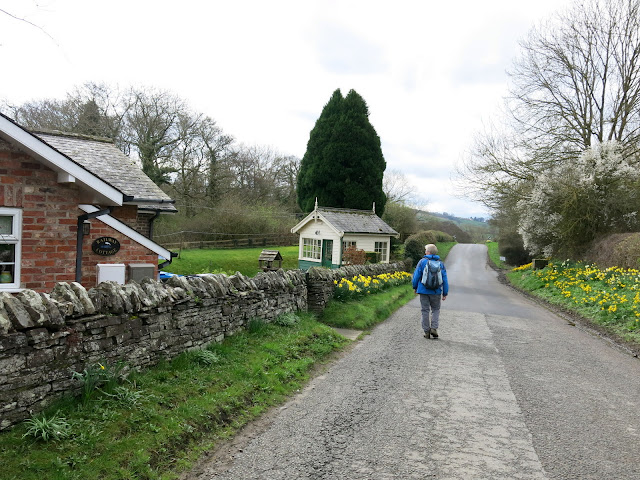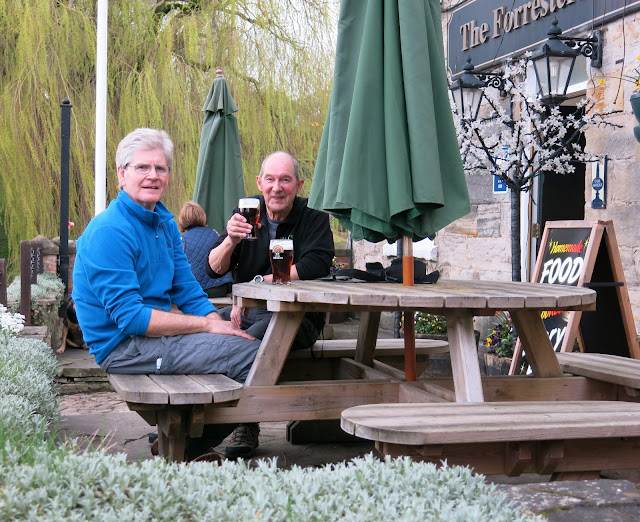Coxwold and Beacon Banks from Kilburn
10.5 miles Quite warm and fair
We have walked this route once before but didn't have time to look round Coxwold's striking church, where Laurence Sterne, the author, was the parish priest.
We approached Kilburn from Thirsk and parked in the large car park next to the Forresters Arms on the High Street.
 |
| Today's walk from The Walker's Guide to the Hambleton Hills |
 |
| Our car park for the day |
Part of today's walk is off our North Yorks OS map but the appropriate map can be downloaded from here.
Leaving the car park by a gate next to the war memorial we approached St Mary's Church and had a brief look around. The mouse symbol of Robert Thomson is carved throughout the church and it is fun to spot, carved often where you least expect to see it on pews, rails, boards etc.
Thomson was a resident of Kilburn and his first commission was from the parish priest at Coxwold, a crucifix, and he is said to have taken up the mouse symbol when he considered the expression 'poor as a Church mouse.'
 |
| St Mary's Church, Kilburn |
 |
| Church window |
 |
| Norman grave slab |
 |
| We can see you! |
 |
| Cryptic verse at St Mary's |
Leaving the church we soon reached a road that took us uphill to High Kilburn where attractive houses surround a village green. Tom Scott Burns tells us that there once was a duck pond in the village green but all that remains of that is the old village pump.
 |
| Old gate in High Kilburn |
 |
| Walking through the green at High Kilburn |
 |
| The village pump |
 |
| Dog and pheasant weather-vane |
We spotted a couple of new (to us) weather vanes today, the first above, and I must remember to add them to our collection. (see here)
As we approached the weathered barn (as shown on above map) we saw some very new lambs, barely able to stand, of a breed of sheep new to us with ginger coloured faces.
We pressed on and soon reached Fox Folly Farm where last year we saw a tiny calf, which the farmer had explained was the survivor of a twin birth. Today, in a field by itself, was a young brown heifer and as we were wondering if this was the adult calf, the farmer appeared so we asked him. No, that calf was a male so went to market and this heifer is alone in the field because it's "shy to the trough". I asked what he meant and he explained that it would stand back and let all the other cows feed and would therefore get no food. The only way to stop it from starving was to keep it alone.
 |
| Weather vane at 'weathered barn' |
 |
| Walking towards Fox Folly Farm |
 |
| Fox Folly Farm |
 |
| Last year's baby |
 |
| Shy and "Shy to the trough" |
Leaving the farmer we walked along the lane for a couple of hundred yards and turned into a field after which we followed field paths, sometimes very muddy, until we reached the village of Coxwold.
 |
| Into fields for the next mile |
 |
| Heavy going |
 |
| Unusual bridge stile |
 |
| New sign |
 |
| Looking back to the White Horse, Fox Folly Farm in the foreground |
 |
| Approaching Coxwold High Street |
We walked along the high street until we reached Shandy Hall, the home of Laurence Sterne, the author of Tristram Shandy, and then walked back on the other side to the church, which seems enormous for the size of the village.
 |
| Coxwold High Streeet |
 |
| Laurence Stern's house |
 |
| Shandy Hall |
St Michael's Church has an impressive octagonal tower and is a 15th century building, although built on a Norman church. We found it unlocked and went inside to see some fine windows, which commemorated the Wombwell family, in particular Sir George Orby Wombwell, a survivor of the Charge of the Light Brigade. There was also a fine stone carving dedicated to the Fauconberg family of Yarm, near our neck of the woods.
 |
| St Michael's Church, Coxwold |
 |
| Looking towards the altar |
 |
| A monument to Laurence Sterne |
 |
| Medieval figurines in St Michael's Church |
 |
| Statue of the Fauconbergs of Yarm |
 |
 |
| Looking towards the organ |
 |
| Wombwell's windows |
We went outside and read some of the old gravestones before returning to the High Street and walking back to the crossroads where we turned right to commence a steady climb out of the village. After half a mile we entered a field at a wooden sign and continued to climb following field paths until we reached a stile and High Leys Farm.
 |
| We wondered why some 'N's are reversed. Dyslexic stone mason? |
 |
| The Old Almshouse, Coxwold |
 |
| Passing the old station, now a house with signal box still containing signs and lamps |
 |
| Leave the road here |
 |
| Climbing, Coxwold in the distance |
 |
| Fancy hen at High Leys Farm |
 |
| Leave the farm track at this sign |
 |
| Our view from our coffee stop |
 |
| Our seat |
 |
| Looking down on Husthwaite as we descend from Beacon Bank |
 |
| Alpacas |
 |
| Craft sign in Husthwaite |
 |
| Another 'new' weather vane |
 |
| Early clematis in Husthwaite |
 |
| Wesleyan Chapel and magnolia |
 |
| Old houses in Husthwaite |
 |
| Church weather-vane |
 |
| St Nicholas' Church |
 |
| Topiary in Husthwaite |
After Husthwaite we passed through the remains of an old railway embankment and entered Ings Lane, which we followed north for a mile. We walked by a tractor garage and shop, with some big machines, one of which was being tested up and down Ings Lane, passing and re-passing us, the driver giving us a cheery wave each time. We rejoined the road at Carlton Husthwaite and walked through the village, noting its pretty houses, one of which was very striking, a timber framed thatched house.
 |
| Ings Lane |
 |
| "Eleven wheels on my wagon..." |
 |
| Tractors, old and new |
 |
| Lots of Spring lambs today |
 |
| Blacksmith's forge at Carlton Husthwaite |
 |
| Forge decoration |
 |
| Timber framed house in Carlton Husthwaite |
 |
| Returning to Kilburn |
 |
| Our path is clearly laid out |
 |
| This bird scarer gave us a shock |
 |
| Nearly back |
 |
| In a tree near Kilburn! |
 |
| Old horse is pleased to see Clive... and his apple |
 |
| Only his mother could love him |
 |
| Walking through Kilburn |
 |
| The Hiker's Reward |















